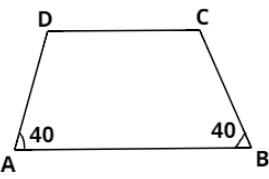Answer
415.8k+ views
Hint: In trapezium, the sum of two adjacent angles made by parallel lines is ${180^ \circ }$. Use this theorem for the pair of angles made by parallel sides and find the required angles.
Complete step by step answer:

From the above figure, ABCD is a trapezium in which AB is parallel to DC and we have:
$ \Rightarrow \angle A = \angle B = {40^ \circ }.$
We know that, in trapezium, the sum of two adjacent angles made by parallel lines is ${180^ \circ }$. Thus, according to this rule, we have:
$ \Rightarrow \angle A + \angle D = {180^ \circ }$ (sum of interior angle on the same side of the transversal is ${180^ \circ }$)
$
\Rightarrow \angle D = {180^ \circ } - \angle A \\
\Rightarrow \angle D = {180^ \circ } - {40^ \circ } \\
\Rightarrow \angle D = {140^ \circ } \\
$
Similarly for other two angles:
$
\angle B + \angle C = {180^ \circ } \\
\Rightarrow {40^ \circ } + \angle C = {180^ \circ } \\
\Rightarrow \angle C = {140^ \circ } \\
$
Hence the measure of the other two angles is ${140^ \circ }$ each.
Note: If in a trapezium, non-parallel sides are equal in length then in that case, the opposite angles of the trapezium will be supplementary to each other. And such trapezium is called isosceles trapezium.
Complete step by step answer:

From the above figure, ABCD is a trapezium in which AB is parallel to DC and we have:
$ \Rightarrow \angle A = \angle B = {40^ \circ }.$
We know that, in trapezium, the sum of two adjacent angles made by parallel lines is ${180^ \circ }$. Thus, according to this rule, we have:
$ \Rightarrow \angle A + \angle D = {180^ \circ }$ (sum of interior angle on the same side of the transversal is ${180^ \circ }$)
$
\Rightarrow \angle D = {180^ \circ } - \angle A \\
\Rightarrow \angle D = {180^ \circ } - {40^ \circ } \\
\Rightarrow \angle D = {140^ \circ } \\
$
Similarly for other two angles:
$
\angle B + \angle C = {180^ \circ } \\
\Rightarrow {40^ \circ } + \angle C = {180^ \circ } \\
\Rightarrow \angle C = {140^ \circ } \\
$
Hence the measure of the other two angles is ${140^ \circ }$ each.
Note: If in a trapezium, non-parallel sides are equal in length then in that case, the opposite angles of the trapezium will be supplementary to each other. And such trapezium is called isosceles trapezium.
Recently Updated Pages
The branch of science which deals with nature and natural class 10 physics CBSE

The Equation xxx + 2 is Satisfied when x is Equal to Class 10 Maths

Define absolute refractive index of a medium

Find out what do the algal bloom and redtides sign class 10 biology CBSE

Prove that the function fleft x right xn is continuous class 12 maths CBSE

Find the values of other five trigonometric functions class 10 maths CBSE

Trending doubts
Difference between Prokaryotic cell and Eukaryotic class 11 biology CBSE

Fill the blanks with the suitable prepositions 1 The class 9 english CBSE

Two charges are placed at a certain distance apart class 12 physics CBSE

Difference Between Plant Cell and Animal Cell

What organs are located on the left side of your body class 11 biology CBSE

Change the following sentences into negative and interrogative class 10 english CBSE

The planet nearest to earth is A Mercury B Venus C class 6 social science CBSE

The Equation xxx + 2 is Satisfied when x is Equal to Class 10 Maths

What is BLO What is the full form of BLO class 8 social science CBSE



